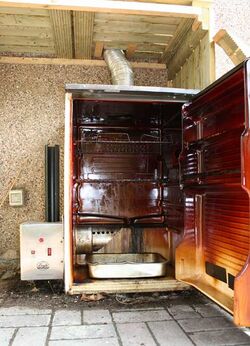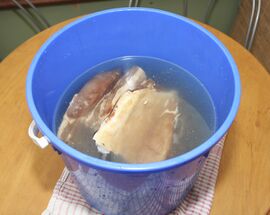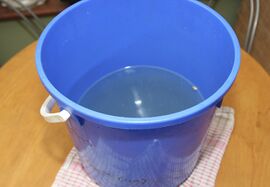Home cured bacon

I first started home curing bacon more than 5 years ago after seeing a River Cottage tv program. I have made it twice a year, every year since. Apart from when I tried a full ham, I have not had any failures, though some turn out better than others.
Because the drying has to be done outside (southern UK), it's too warm after April or before October to dry it safely so I do two lots a year now, one starting in October, and another starting in January.
Although I always refer to this as bacon, it is completely cured and perfectly safe to eat raw. I use it a an equivalent for Parma ham or Prosciutto. It is rarely cooked.
Basic procedure
I get the bacon from a local butchers. The cut I get is the full back pork loin, no bones, rind removed. It's about 1' 6" long.
I've tried a ham (the butcher boned it for me) but it went green and smelly where the bone was so I had throw it out. I only use pork loin.
First wash and dry it under a cold tap and trim any loose pieces off and discard. Pat dry with a towel and cut into four lengths. It's just easier to store when it's in smaller pieces.
Because of the possible risk of botulism associated with a salt only cure, and the risks associated with the use of saltpeter, I have always used commercial cures that contain very carefully measured levels of salpetre that reduces the risk. I use Wright's Sweet dry cure + smoke. Wear rubber gloves when handling the raw bacon and be meticulous about hygiene.
Salting

For the salting process, I use a large plastic tub with a lid. The tub has holes drilled in the bottom. Measure out 137 grams cure per 1 kg bacon or whatever is recommended by your cure provider. Don't over do it though or you will wind up with a salt-lick instead of bacon. Sprinkle about half the cure over the surface of the bacon, sandwiching the bacon in layers and covering with a plastic lid which is weighed down to compress the bacon. Turn the bacon and drain the liquid that is released on a daily basis at first, then every few days for about 10 days in all. When no more liquid is released from the bacon, it's ready for the next stage.
Smoking
I then smoke the bacon in my home made smoker for a day, using about 10 briquettes.
Rinsing

Rinse the bacon for an hour or so in a bowl under a slow running cold tap to remove any excess salt.
Sweet flavouring
To flavour the bacon I use molasses though I'm sure there are many other ways. I make a mixture of about 65/53 (molasses/water) by pouring boiling water over the molasses, stirring until well mixed and then leave until cold. Pour this mixture over the bacon, cover and leave for five days in a cool place. After five days, remove and pat dry with a towel.
Drying

Wrap the bacon tightly in muslin so no insects can get in and pour red wine vinegar over the muslin so it is really well soaked. I then hang the bacon in a bird proof cage for 3 to four months. It must be somewhere that has good ventilation and also out of the rain. Once the bacon has been air dried for three months, unwrap and wash with red wine vinegar, allow to dry and store in the refrigerator until you are ready to use it. If you have somewhere cool to store it you may not need to refrigerate it, however, this way it keeps for at least a year and is brilliant all sorts of recipes. You will now need a bacon slicer!

Pictured step-by-step
-
5.4 kg of rindless pork loin - vacuum packed
-
First salting - layered
-
First salting, angled for easy drainage
-
Plastic lid used to separate pressing weights
-
1 week on showing 2 day's desiccation & weights (bagged up hammers!)
-
After 2 weeks salting
-
Use displacement to work out how much liquid you'll need
-
Remove the bacon and measure the remaining liquid
-
Ingredients for the next step: Cold water to cover, 2 tablespoons coriander seeds, 2 tablespoons fennel seeds, 1 kg brown sugar
-
bring to the boil, stir, then allow to go cold (6 hours)
-
Rinse under cold running water for 2 hours
-
Cover with sugar water and spices and leave in a cool place for one week
-
After 1 week in the molasses and spices
-
Into the smoker for 2 days (smoke with 4 briquettes, leave bacon in smoker, switch it off, repeat the following day)
-
The bacon is now smoked
-
Sewn into the muslin - it doesn't need to be neat!
-
Air-drying - see you again in March!
See also
Find recipes that contain 'Home cured bacon'
#homecuredbacon #muslin #saltpeter #smoked #dehydrated #processedmeatleadstoanearlydeath #salpetre #botulism #prosciutto #molasses #bones
















